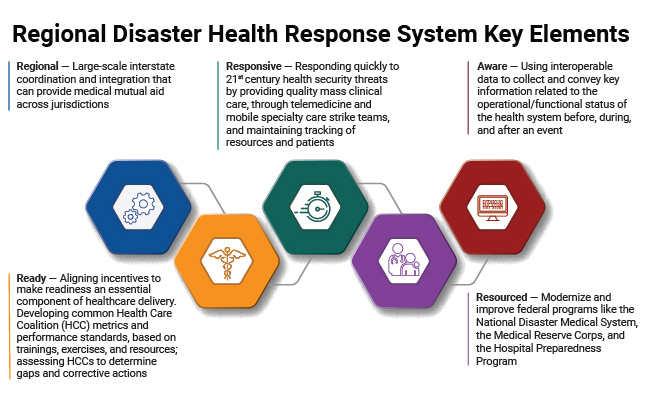Regional Disaster Health Response System: An Overview
When disaster strikes, patients need their health care system to be ready to respond. However, as recent hurricanes and other large-scale emergencies have shown, being able to function effectively in a crisis is challenging for even the most prepared health care systems, communities and jurisdictions.
ASPR aims to address gaps in coordinated patient care during disasters through the establishment and maturation of a new Regional Disaster Health Response System (RDHRS). As part of the RDHRS, ASPR aims to establish a network of state-level clinical response assets as well as inter-state regional assets to create a more coherent, comprehensive, and capable health care disaster response system that can respond to 21st century health security threats and integrate into daily care delivery systems.
ASPR is looking at innovative approaches to building the RDHRS and continuing the dialogue with our state and local health system partners to explore various avenues to develop the system. In 2018, ASPR invested in two RDHRS sites to serve as demonstration projects that address health care preparedness challenges, establish best practices for improving disaster readiness across the health care delivery system, and show the potential effectiveness and viability of an RDHRS. These sites are led by Massachusetts General Hospital and Nebraska Medicine. In 2020, ASPR built on the success of these partnerships by adding a third recipient, Colorado/Mountain Plains Regional Disaster Health Response System.
RDHRS Goals
The four primary goals of the RDHRS are to:

Building the RDHRS
ASPR is building a new system for catastrophic disaster medical care. Current investments in healthcare preparedness – including its Hospital Preparedness Program, National Disaster Medical System, Regional Emergency Coordinators, Medical Reserve Corps, and Regional Treatment Network for Ebola and Other Special Pathogens -- will serve as the foundation for the new system.
The network system will also include trauma centers, burn centers, pediatric hospitals, public health labs, outpatient services, and federal facilities like Veterans Affairs clinics working together to better meet the health care needs of the public in a disaster. Through the RDHRS, ASPR aims to optimize clinical surge capacity, provide clinical expertise to support healthcare surge planning, and ensure that appropriate clinical expertise is integrated as a partner in emergency planning and response.
The RDHRS will be a tiered system that builds upon the existing Medical Surge Capacity and Capability (MSCC) foundation for local medical response, including trauma systems and healthcare coalitions, by enhancing coordination mechanisms and strengthening connections between clinical and administrative capabilities at the state and regional levels.
A regional disaster health response system combines the best of the health care coalition approach with this tiered model, thereby building coordinated capabilities for all types of disasters by expanding the concept beyond diseases to include readiness for chemical, biological, and radiological attacks.
The RDHRS is intended to define enhance the delivery of clinical care when the existing referral patterns and health care delivery capacity and capabilities are exceeded by catastrophic events.
The RDHRS is not intended to alter or displace current local patient referral patterns and it will not replace the assistance HHS now provides through the Hospital Preparedness Program, National Response Framework and the National Disaster Recovery Framework, or our federal disaster response teams, such as teams from the National Disaster Medical System (NDMS).
A RDHRS will not be built overnight. ASPR looks forward to continuing the dialogue with our state and local health system partners to explore various avenues to support this system.


